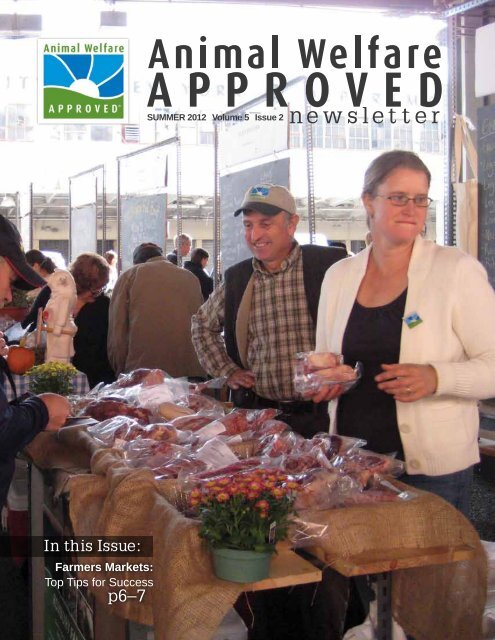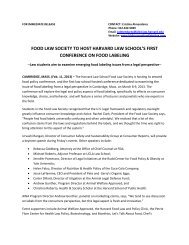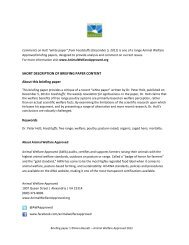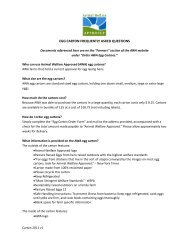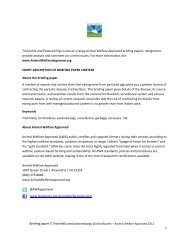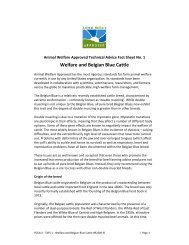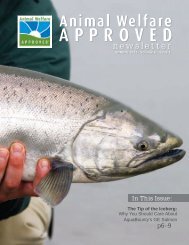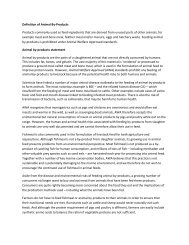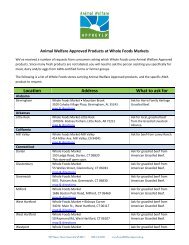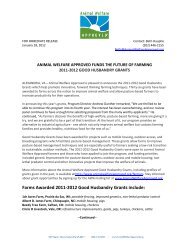Summer 2012 Animal Welfare Approved Newsletter
Summer 2012 Animal Welfare Approved Newsletter
Summer 2012 Animal Welfare Approved Newsletter
You also want an ePaper? Increase the reach of your titles
YUMPU automatically turns print PDFs into web optimized ePapers that Google loves.
SUMMER <strong>2012</strong> Volume 5 Issue 2<br />
newsletter<br />
In this Issue:<br />
Farmers Markets:<br />
Top Tips for Success<br />
p6–7
Dear Friends,<br />
<strong>2012</strong> is already a year that the<br />
intensive livestock industry would<br />
like us to forget. Media coverage<br />
of ammonia-treated boneless lean<br />
beef trimmings (BLBT)—otherwise<br />
known as “pink slime”—resulted in<br />
an extraordinary public backlash,<br />
particularly when we learned that<br />
70 percent of ground beef sold in<br />
the U.S. contained unlabeled BLBT.<br />
Weeks later, news broke that a dead cow in California tested<br />
positive for “atypical” bovine spongiform encephalopathy<br />
(BSE, or “mad cow disease”). While the USDA claimed that<br />
the public had nothing to fear, the fact that the case was<br />
detected purely by chance did not go unnoticed.<br />
What most commentators failed to note, however, is<br />
that the “pink slime” fiasco and BSE are both the indirect<br />
outcomes of the incessant drive to further industrialize<br />
livestock farming and meat processing. In both cases, a<br />
novel technology was introduced (essentially) out of public<br />
sight with the primary aim of utilizing slaughterhouse<br />
waste to minimize industry costs. Most consumers had no<br />
idea that ruminant remains were being ground up and fed<br />
back to other ruminants; similarly, the meat processing<br />
industry did very little—if anything—to inform the public<br />
that BLBT was being added to most ground beef.<br />
I believe that the recent public outcry is a symptom<br />
of years of latent concern about the over-industrialization<br />
of food production. Indeed, many consumers now have a<br />
profound feeling that, when it comes to food production,<br />
the pendulum has swung too far towards the surreptitious<br />
introduction of questionable practices on the basis of “what<br />
can make us the most money—regardless of the costs.”<br />
And the intensive meat industry is now paying the price.<br />
Andrew Gunther<br />
Program Director<br />
contents<br />
2 Dear Friends<br />
Letter from Andrew Gunther<br />
3 Top News<br />
New Study: Consumers<br />
Reward Transparent Labeling<br />
3 GOOD husbandry grants<br />
A Call for <strong>2012</strong>–2013<br />
AWA Good Husbandry<br />
Grant Proposals<br />
4 News in Brief<br />
White House Honors AWA<br />
Farmers; Cochon 555<br />
Success; AWA Farm-to-Farm<br />
Sales<br />
5 Farmer profile<br />
Meet Deborah Stone of<br />
Stone Hollow Farmstead<br />
5<br />
8<br />
newsletter<br />
6 SUPPORT<br />
Making the Most of<br />
Farmers Markets<br />
<strong>Summer</strong> <strong>2012</strong><br />
Volume 5 · Issue 2<br />
8 DISCUSSIon<br />
Grassfed Beef is<br />
Greener—And That's<br />
a Fact<br />
10 Notes from the field<br />
Addressing Public<br />
Complaints<br />
11 Meet the Farmer<br />
Chris Kerston Of Chaffin<br />
Family Orchards<br />
11 AWA ServICes<br />
Free Marketing<br />
Materials—Order Today!<br />
6<br />
11<br />
Cover Photo: Jean-Paul Courtens and Jody Bolluyt of Roxbury Farm, NY (Brigid Sweeney);<br />
Contents Photos: Goat at Stone Hollow Farmstead, AL (Brian Francis Photography);<br />
Farmers market (Mike Suarez); Cattle at Rain Crow Ranch, MO (Mike Suarez);<br />
Poultry at Chaffin Family Orchards, CA (Chaffin Family Orchards)<br />
AWA <strong>Newsletter</strong><br />
staff<br />
Program Director<br />
Andrew Gunther<br />
Lead Auditor<br />
Tim Holmes<br />
Program Coordinator<br />
Julie Suarez<br />
Program Assistant<br />
Amanda Kisner<br />
Auditors<br />
Lance Gegner<br />
Charlie Hester<br />
Ken Smith<br />
Lead Farmer and Market Outreach<br />
Coordinator<br />
Emily Lancaster<br />
Farmer and Market Outreach Coordinators<br />
Eve Cohen<br />
Beth Spitler<br />
Paul Servideo<br />
Communications Associate<br />
Katie Baumer<br />
Educational Outreach Coordinator<br />
Wendy Swann<br />
Writer/Editor<br />
Peter Mundy<br />
Graphic Designer<br />
Alexandra Alberg<br />
consultants<br />
Auditors<br />
Kim Alexander<br />
Dr. Karen Anderson<br />
Dr. Jennifer Burton<br />
Dr. Jan Busboom<br />
Karen Haverinen Lehto<br />
Tim Linquist<br />
Richard Long<br />
Frank Morison<br />
Stan Pace<br />
Rob Stokes<br />
Dr. Mick Weirich<br />
Dr. Wendy Weirich<br />
Technical<br />
Anna Bassett<br />
Corrective Action<br />
Plan Coordinator<br />
Chris Peckham<br />
For subscription inquiries or other information,<br />
contact AWA at 1007 Queen Street,<br />
Alexandria, VA 22314. Tel: (800) 373-8806;<br />
Fax: (202) 446-2151. Visit our website at<br />
www.<strong>Animal</strong><strong>Welfare</strong><strong>Approved</strong>.org or e-mail<br />
us at Info@<strong>Animal</strong><strong>Welfare</strong><strong>Approved</strong>.org.<br />
Join our e-mail list at:<br />
www.<strong>Animal</strong><strong>Welfare</strong><strong>Approved</strong>.org.<br />
Read and comment on our blog at:<br />
www.<strong>Animal</strong><strong>Welfare</strong><strong>Approved</strong>.org/blog.<br />
@AWAapproved<br />
www.facebook.com/<br />
<strong>Animal</strong><strong>Welfare</strong><strong>Approved</strong><br />
2
New Study: Consumers Reward Transparent Labeling<br />
<strong>Animal</strong> <strong>Welfare</strong> <strong>Approved</strong> and East Carolina University have published a landmark study on consumer preferences<br />
for sustainable food products when they are traveling, dining out, and eating at home.<br />
By Peter Mundy, Writer/Editor<br />
Top News<br />
<strong>Animal</strong> <strong>Welfare</strong> <strong>Approved</strong><br />
2011 <strong>Animal</strong> Products<br />
Survey Results<br />
Conducted by<br />
<strong>Animal</strong> <strong>Welfare</strong> <strong>Approved</strong><br />
and East Carolina University's<br />
Center for Sustainable Tourism<br />
Carol Kline, Alison Murray, and Emily Lancaster<br />
April 15, <strong>2012</strong><br />
A new<br />
report by<br />
<strong>Animal</strong><br />
<strong>Welfare</strong><br />
<strong>Approved</strong><br />
and the<br />
Center for<br />
Sustainable<br />
Tourism<br />
at East<br />
Carolina<br />
University<br />
offers good<br />
news for sustainable farmers, as<br />
well as the growing number of<br />
retailers and restaurants that sell<br />
sustainable food.<br />
Researchers from East Carolina<br />
University conducted an online survey<br />
of almost 2,000 consumers across<br />
the U.S., focusing on their food<br />
choices. Almost half of respondents<br />
reported that they included<br />
sustainable meat, dairy, and/or eggs<br />
in 1–5 of their meals each week,<br />
while the vast majority of respondents<br />
believed that sustainable products<br />
are better for the environment (93.8<br />
percent), healthier (89.6 percent),<br />
more nutritious (80.8 percent), better<br />
tasting (80.7 percent), and safer (86.3<br />
percent) than conventionally raised<br />
animal products.<br />
Most respondents also indicated<br />
that they would be willing to pay more<br />
for sustainably raised meat, dairy and<br />
eggs, but that these products were<br />
often difficult to find in their local chain<br />
grocery stores. With over 60 percent<br />
of the respondents stating that they<br />
regularly shop in chain grocery stores,<br />
the survey points to the potentially<br />
significant future market opportunities<br />
for sustainable farms.<br />
The theme of transparency was<br />
a common thread throughout the<br />
study, and was most apparent in the<br />
overwhelming consumer demand<br />
for transparent labeling. Nearly all<br />
respondents said that clear<br />
labeling for animal products<br />
was very important to<br />
increasing the production<br />
and consumption of<br />
sustainably raised meat.<br />
“This study confirms<br />
what we have been<br />
advocating all along—that<br />
informed consumers will<br />
make sustainable food<br />
choices when they are<br />
given the opportunity,” says<br />
Andrew Gunther, AWA<br />
Program Director.<br />
“The report also<br />
emphasizes the need for<br />
Rapid Eye Media<br />
clear and transparent product<br />
labeling to better educate and inform<br />
consumers, as well as to attract new<br />
customers. Sustainable farmers<br />
would do well to digest the findings<br />
of this study and ensure that their<br />
food labeling and marketing materials<br />
clearly reflect the core values that<br />
today’s conscientious consumers are<br />
looking for when they are shopping for<br />
their food.”<br />
Download a full copy of the<br />
report, <strong>Animal</strong> <strong>Welfare</strong> <strong>Approved</strong> 2011<br />
<strong>Animal</strong> Products Survey Results, at<br />
http://bit.ly/KD71gq or call the AWA<br />
office at (800) 373-8806.<br />
The survey found that while most consumers would pay<br />
more for sustainably raised meat, dairy and eggs, these<br />
products were often difficult to find in the chain grocery<br />
stores where over 60 percent of them shopped.<br />
Call for <strong>2012</strong>–2013 AWA Good Husbandry Grant Proposals<br />
<strong>Animal</strong> <strong>Welfare</strong> <strong>Approved</strong> is pleased to announce a<br />
call for proposals for its <strong>2012</strong>–2013 Good Husbandry<br />
Grants program.<br />
Now in its fifth year, the Good Husbandry Grants<br />
program has funded over one hundred projects across<br />
the U.S. to improve farm animal welfare. AWA farmers,<br />
and those who have submitted an application for AWA<br />
certification, can apply for up to $5,000 toward projects<br />
such as mobile housing, breeding stock, and on-farm<br />
processing equipment. Slaughter plants working with<br />
or seeking to work with AWA farmers are also eligible<br />
for funding.<br />
The funding priorities for this year's cycle include<br />
improved genetics and increased outdoor access.<br />
AWA's Good Husbandry Grants program will also<br />
continue its focus on welfare improvements in the<br />
slaughter process.<br />
Profiles of previous Good Husbandry<br />
Grant recipients are available online at www.<br />
<strong>Animal</strong><strong>Welfare</strong><strong>Approved</strong>.org/farmers, along with<br />
guidelines for applying, FAQ and an application<br />
form. If you have any questions contact AWA<br />
Grants Coordinator Emily Lancaster at Emily@<br />
<strong>Animal</strong><strong>Welfare</strong><strong>Approved</strong>.org or (202) 618-4497.<br />
<strong>Summer</strong> <strong>2012</strong><br />
3
AWA <strong>Newsletter</strong> News in Brief<br />
4<br />
ARSENIC FEED BAN<br />
Maryland has become the first state<br />
to ban the use of arsenic in intensive<br />
chicken production.<br />
The new law, which comes into<br />
effect on January 1, 2013, follows<br />
an FDA study last year which found<br />
traces of inorganic arsenic in the livers<br />
of intensively raised chickens, where<br />
arsenic is used to prevent coccidiosis.<br />
Arsenic is a known carcinogen and is<br />
linked to numerous other human health<br />
concerns. AWA standards have never<br />
permitted its use.<br />
“We welcome this new law,”<br />
says Tim Holmes, AWA Lead Auditor.<br />
“Maryland is the seventh largest broiler<br />
producing state and we hope other<br />
states will now follow suit. However,<br />
we are concerned that a loophole<br />
may allow some poultry farmers to<br />
use arsenic compounds in their birds’<br />
drinking water.”<br />
WHITE HOUSE HONORS FARMERS<br />
Chad and Jodi Ray, of Ray Family<br />
Farms in Louisburg, NC, were honored<br />
by the White House in April as<br />
“Champions of Change.”<br />
The award is in recognition of the<br />
Rays’ efforts to prove that corporate<br />
environmental leadership makes<br />
sense, both for business and for<br />
local communities. Selling beef, pork,<br />
poultry and vegetables from their<br />
170-acre farm to local customers, the<br />
Rays are also committed to on-farm<br />
education, environmental stewardship,<br />
and green energy.<br />
“The AWA mission and brand<br />
means a lot to people," explained<br />
Chad. "I believe it is part of why we<br />
were selected. It just proves that this<br />
whole movement means something—<br />
that the White House would take notice<br />
of just one farm in North Carolina.”<br />
COCHON 555 SUCCESS<br />
Two AWA farms have supplied winning<br />
hogs for the prestigious Cochon 555<br />
competition—a 10-city culinary tour<br />
where 50 renowned local chefs must<br />
prepare a “snout-to-tail” menu using<br />
only traditional pig breeds.<br />
AWA-certified Palmetto Creek<br />
Farms, FL, supplied a Hereford pig<br />
to the winning chef at the Miami<br />
competition, while Leaping Waters<br />
Maryland's lawmakers have banned<br />
the feeding of arsenic compounds<br />
in intensive poultry systems.<br />
Farm, VA, supplied a Red Wattle pig<br />
which was used to win the Washington,<br />
DC, competition. Cochon 555<br />
culminates in a Grand Finale in Aspen,<br />
CO, where the 10 winning chefs will<br />
compete to become the "King/Queen<br />
of Porc."<br />
AWA FARM-TO-FARM SALES<br />
AWA farmers can now sell breeding<br />
or feeder stock, farm equipment or<br />
supplies to other farmers using AWA’s<br />
new online Farm-to-Farm Sales page.<br />
Farmers can view current entries<br />
and download the Farm-to-Farm<br />
Advertisement Application Form at<br />
www.<strong>Animal</strong><strong>Welfare</strong><strong>Approved</strong>.org/<br />
farmers/classifieds—or call<br />
(800) 373-8806 for more information.<br />
NEW AWA STAFF<br />
AWA has recently appointed two new<br />
staff members.<br />
“We are delighted to welcome<br />
Katie Baumer and Paul Servideo to<br />
the team,” says Andrew Gunther,<br />
AWA’s Program Director. “Katie joins<br />
us as Communications Associate<br />
and will guide our traditional and<br />
social media communication activities,<br />
ensuring that news from the program<br />
and our farmers reaches the broadest<br />
audience.<br />
“Paul joins our Farmer and<br />
Market Outreach team as Coordinator<br />
for the Northeast region, taking over<br />
for Brigid Sweeney, who recently<br />
relocated to California. Paul will be<br />
responsible for supporting new and<br />
existing AWA farmers across the<br />
region, as well as raising consumer<br />
awareness about the wide-ranging<br />
benefits of the AWA program.”<br />
AWA EGGS HIT THE SPOT<br />
AWA eggs are recommended as<br />
the best choice for healthy, ethically<br />
produced eggs, according to a review<br />
by EthicalFood.com.<br />
“In the absence of a local,<br />
pasture-based farmer, you may have<br />
to rely on labels when buying from a<br />
grocery store,” advises EthicalFood.<br />
com. “<strong>Animal</strong> <strong>Welfare</strong> <strong>Approved</strong><br />
is a comprehensive and rigorous<br />
certification.”<br />
Ensa<br />
USDA LABEL APPROVAL<br />
The USDA’s Food Safety and<br />
Inspection Service has launched a<br />
new online approval system for meat,<br />
poultry, and egg product labels.<br />
“The USDA is hoping this new<br />
online system will streamline the<br />
label approval process and allow<br />
businesses to track their submissions,”<br />
says Emily Lancaster, AWA’s Labeling<br />
Coordinator. “Remember that AWA<br />
can help you to design professional<br />
food labels for your products and guide<br />
you through the mandatory approval<br />
process—all at no charge.”<br />
For details of AWA’s<br />
labeling service, visit www.<br />
<strong>Animal</strong><strong>Welfare</strong><strong>Approved</strong>.org/<br />
farmers/labeling or contact Emily<br />
Lancaster at (202) 618-4497.<br />
HUMANE COYOTE CONTROL<br />
AWA-certified Barinaga Ranch in Marin<br />
Country, CA, was featured in the San<br />
Francisco Chronicle in an article about<br />
the increasing use of guardian dogs.<br />
Marcia Barinaga of Barinaga<br />
Ranch relies on Great Pyrenees<br />
guardian dogs—rather than traps,<br />
poison, or bullets—to protect her flock<br />
of dairy sheep from coyotes. “I see<br />
coyotes on the ranch all the time,” she<br />
says. “But we have lost no sheep at all<br />
to predators.”<br />
PHOTO CORRECTION<br />
The photograph of sheep on the back<br />
cover of the Spring AWA <strong>Newsletter</strong><br />
was taken at Weirauch Farm and<br />
Creamery in Petaluma, CA, and not<br />
Border Springs Farm, as indicated.<br />
We apologize for the error.
Deborah Stone: Getting Back to the Land<br />
Deborah Stone sold her pioneering day spa business in 1999 to establish Stone Hollow Farmstead with<br />
her family in Harpersville, AL. She now supplies award-winning goat cheese to several major retail outlets.<br />
I come from a long line of Alabama gardeners and farmers,<br />
so in my heart I always wanted to return to farming. After<br />
leaving home, however, I trained as an aesthetician, opening<br />
a day spa in Birmingham, AL, in 1989. At that time, it was<br />
only the third day spa in the U.S.—and the only one in the<br />
Southeast. It turned out to be a very successful venture and,<br />
in 1999, we sold the business to a larger company.<br />
After the sale my husband, Russell, asked “Well, what<br />
do you want to do now?” I immediately said that I wanted to<br />
go back to farming. I wanted my children to experience the<br />
rural lifestyle that I enjoyed when growing up. We already<br />
owned a small number of Hanoverian horses, so the initial<br />
plan was to import more breed mares and set up a breeding<br />
facility. We found suitable farmland just outside Harpersville<br />
and called it Stone Hollow Farmstead.<br />
One of my lifelong goals was to develop my own line of<br />
medicinal skincare products, so I started growing therapeutic<br />
herbs on the farm. In 2003, I launched the Botaniko skincare<br />
brand, incorporating botanical extracts from herbs grown<br />
and processed at our lab on the farm. Although we were<br />
already growing vegetables to feed our family, I wanted the<br />
farm to be completely self-sufficient, producing our own milk<br />
and meat. We bought a small number of goats, and it wasn’t<br />
long before I was making cheese with the excess milk. We<br />
gave some to friends and family, and they loved it. Inspired<br />
by other artisan producers, we began to build up the herd<br />
and started selling cheese to local restaurants and grocery<br />
stores, and soon we couldn’t keep up with demand. As luck<br />
would have it, we were introduced to a local goat farmer,<br />
Ralph Hayes. With his additional milk supply, we were<br />
able to establish a dairy processing facility on the farm and<br />
significantly increase production. It’s a great arrangement.<br />
We have around 150 goats (Saanen for volume and<br />
Alpine and Nubian for butterfat), with Ralph milking 80–100<br />
Brian Francis Photography<br />
Farm at a Glance<br />
Farm: Stone Hollow Farmstead, Harpersville, AL<br />
AWA certified: 2011<br />
Size: 80 acres (plus grazing on linked AWA farm)<br />
Altitude: 450 feet<br />
Enterprises: 150 Saanen, Alpine and Nubian goats<br />
producing 300 lbs of cheese a week. On-farm lab<br />
producing skincare brand with farm botanical extracts.<br />
Deborah Stone (right)<br />
with her daughter,<br />
Alexandra, who<br />
is responsible for<br />
product development<br />
and public relations at<br />
the farm.<br />
at any one time.<br />
We produce and<br />
pack about 300<br />
lbs of cheese a<br />
week, using many<br />
ingredients from<br />
the farm, such<br />
as chives, honey,<br />
figs, olives, garlic,<br />
tomatoes and basil.<br />
We supply numerous high-end restaurants, as well as<br />
retailers such as Whole Foods Market and Piggly Wiggly<br />
stores, and recently started supplying KeHe Distributors,<br />
one of the country’s largest wholesale distributors of<br />
natural and specialty food products.<br />
Selling to the food service industry<br />
was tremendously helpful in building<br />
our brand and it provided useful cash<br />
flow while we developed our retail sales.<br />
Good chefs are always looking for local<br />
food and variety, but they’re busy people.<br />
So if you are looking to supply them,<br />
take product samples and professionally<br />
designed point-of-sale information, and<br />
then leave them to try it. Getting our<br />
farm name on their menus really was<br />
priceless promotion.<br />
Alexandra Stone<br />
Deborah Stone recently opened The Pantry<br />
in Birmingham, AL, as a retail outlet for her<br />
cheese and other farm products, with a lunch<br />
and takeout farm-to-table menu. Visit www.<br />
StoneHollowFarmstead.com.<br />
Farmer Profile<br />
<strong>Summer</strong> <strong>2012</strong><br />
5
AWA <strong>Newsletter</strong> Support<br />
6<br />
Making the Most of Farmers Markets<br />
Farmers markets can provide opportunities for farmers to market their products directly to the consumer.<br />
We offer some key tips for new and veteran vendors alike.<br />
By Stacy Miller, executive director, farmers market coalition<br />
The rapid growth of farmers markets<br />
over the last decade is more than<br />
mere coincidence. I see it as the fruit<br />
of a timely convergence of at least two<br />
key factors: farmer demand for more<br />
viable, human-scaled enterprises<br />
and an awakening among citizenconsumers<br />
that, yes, food can be<br />
fresher, of higher quality, and available<br />
in a system where one’s dollars really<br />
can benefit the local economy.<br />
Given that recent USDA<br />
Economic Research Service data<br />
shows that farmers receive, on<br />
average, less than 16 cents for every<br />
dollar spent on food in traditional<br />
retail outlets, is it any wonder that 1.8<br />
million acres of prime farmland were<br />
lost to development between 2002 and<br />
2007? That’s why it’s so heartening to<br />
see a steady increase in the number<br />
of farms that choose to market directly<br />
to consumers. It’s also why—despite<br />
occasionally being marginalized as<br />
only for “hobby farmers”—farmers<br />
markets can play a critical role in<br />
Mike Suarez<br />
There are now over 6,100 farmers markets<br />
registered in the USDA Farmers Market<br />
Directory—and numbers continue to rise.<br />
revitalizing rural America and inspiring<br />
the next generation to stay on the<br />
farm and develop new enterprises in<br />
response to local community demand.<br />
Capturing a higher percentage of<br />
the shoppers’ retail food dollar through<br />
farmers markets isn’t easy, nor is it<br />
viable for every farm or farmer. But for<br />
those farmers who are willing to try<br />
their hat at some of the tasks typically<br />
performed by those in the market<br />
research, retail, product marketing,<br />
and transportation sectors, it can be<br />
well worth it.<br />
Since I was lucky enough to be<br />
a producer and a manager before<br />
working with the Farmers Market<br />
Coalition (see box on opposite page),<br />
I would like to offer four basic tips for<br />
producers looking to sell at farmers<br />
markets—whether you are a veteran<br />
direct-marketer looking for a new<br />
market or just starting out.<br />
Understand the market<br />
Not all farmers markets are created<br />
equal, and it’s no surprise that wellmanaged<br />
farmers markets tend to<br />
yield higher returns for their producers<br />
than ones eking by with informal, ad<br />
hoc structures. As tempting as it is to<br />
minimize one’s expenses, be wary of<br />
farmers markets that require no fees<br />
from vendors. Effectively promoting<br />
a market requires the ongoing<br />
education, empowerment, and<br />
excitement of a continually expanding<br />
customer base—and not just the<br />
same old customers. That takes time,<br />
skill, and a commitment that’s hard to<br />
replicate year after year, as volunteers<br />
burn out and transfer responsibilities<br />
to someone else.<br />
According to the USDA’s most<br />
recent survey of farmers market<br />
managers, markets with paid<br />
management reported monthly sales<br />
five times greater than those without<br />
Eve Cohen<br />
Ted Berg from Painted Goat Farm, NY, talks<br />
to customers at New Amsterdam Market,<br />
NY. Offering a small selection of samples will<br />
attract potential customers to the stall—and<br />
prove just how good your products taste.<br />
paid managers. So take the time<br />
to learn the mission of the market,<br />
its governance and management<br />
structure, and the kinds of<br />
promotional and educational services<br />
it offers to the community. It’s a good<br />
sign if producers are elected to a<br />
governing board or committee to help<br />
represent the needs of the vendors,<br />
and it ultimately improves the market<br />
for everyone.<br />
Price accordingly<br />
Walmart doesn’t set its prices based<br />
solely on perception of their shoppers’<br />
willingness to pay, or by using your<br />
prices as a reference point. Neither<br />
should you. Know your costs of
Jean-Paul Courtens of Roxbury<br />
Farm, NY, selling grassfed lamb<br />
and pastured pork on the <strong>Animal</strong><br />
<strong>Welfare</strong> <strong>Approved</strong> aisle at the New<br />
Amsterdam Market, NY.<br />
production and make your price fair<br />
both to yourself, your customers, and<br />
the shoppers you haven’t even met<br />
yet. Quality and freshness should be<br />
your points of pride, so be ready to<br />
very politely explain why your prices<br />
might be higher than those at Food<br />
Lion. For many of us, it is value—not<br />
price—that matters most. Be willing to<br />
offer refunds or credits for any product<br />
that doesn’t completely satisfy.<br />
Always clearly display or mark<br />
your prices for each individual item.<br />
If you wait for people to ask “how<br />
much?” you’ve probably already<br />
lost a good chunk of potential sales<br />
from customers who will never bring<br />
themselves to ask, or who suspect<br />
you might change different prices to<br />
different people.<br />
Create a consistent image<br />
Display signage at or above eye level<br />
with your farm name and location, and<br />
bring photos of your animals, where<br />
appropriate. In the end, consumer<br />
trust that you are treating your<br />
livestock humanely comes from a<br />
combination of certification (like AWA)<br />
and knowing that animals actually<br />
look well cared for in a comfortable<br />
outdoor environment.<br />
Don’t forget that much of your<br />
business’s image has to do with<br />
YOU. Whether you remember your<br />
customers from the week before,<br />
whether you smile, whether you ask<br />
them how they’re doing, and whether<br />
you take the time to patiently answer<br />
their questions—even when, after<br />
many hours on your feet and after little<br />
sleep, you’re exasperated by their<br />
confusion about organic vs. pastured<br />
vs. free-range. With the plethora of<br />
terms and claims on today’s food<br />
labels, can you blame them?<br />
Brigid Sweeney<br />
Food safety<br />
Make a commitment to keeping<br />
your customers safe. Display copies<br />
of any permits, certifications, or<br />
licenses relevant to your businesses.<br />
Every state and locality has different<br />
guidances, and the Farmers Market<br />
Coalition has compiled a stateby-state<br />
chart of regulations and<br />
resources pertaining to food safety at<br />
farmers markets to help you become<br />
familiar with the rules of the road<br />
when it comes to accountability for<br />
safe products.<br />
As sustainable farmers already<br />
know, legal tender is not the only<br />
currency exchanged at farmers<br />
markets. Trust is given and received,<br />
and can often yield bigger dividends<br />
than just cash alone.<br />
Further Resources<br />
Growing for Market, the leading trade<br />
publication for farmers who market<br />
direct, offers a free issue available on<br />
their website devoted exclusively to<br />
tips for selling at farmers markets. This<br />
is a valuable resource and I encourage<br />
a thorough read on a rainy day. Visit<br />
www.GrowingforMarket.com.<br />
Additional resources compiled<br />
from around the country are<br />
available in the Farmers Market<br />
Coalition Resource Library at www.<br />
FarmersMarketCoalition.org (select<br />
“resource library” and “farm business<br />
and marketing”).<br />
Farmers market<br />
coalition<br />
The Farmers Market Coalition<br />
(FMC) is a 501(c)(3) nonprofit<br />
dedicated to strengthening<br />
farmers markets for the benefit<br />
of farmers, consumers, and<br />
communities. With the support of<br />
its members—including farmers<br />
market managers, farmers, and<br />
the nonprofits, individuals, and<br />
businesses that want to see<br />
farmers markets thrive—the<br />
FMC acts as a national voice<br />
for farmers markets through<br />
education, networking, and<br />
advocacy. Learn more or<br />
become a member at www.<br />
FarmersMarketCoalition.org.<br />
<strong>Summer</strong> <strong>2012</strong><br />
7
AWA <strong>Newsletter</strong> Technical<br />
Mike Suarez<br />
Grassfed cattle at Rain Crow Ranch, MO. Grassfed farming has a potentially vital role to play in helping to reduce greenhouse gas emissions<br />
through carbon sequestration, where carbon dioxide is absorbed by the growing pasture and locked in the soil within the plant’s root system.<br />
Grassfed Beef<br />
is Greener—And<br />
That’s a Fact<br />
Feeding cattle on grass throughout their life-cycle is<br />
the most environmentally sustainable way to raise beef,<br />
according to a new report from the UK’s National Trust.<br />
By peter mundy, writer/editor<br />
As concerns over global greenhouse gas (GHG) emissions<br />
and the potential impact of climate change have intensified,<br />
the agricultural industry has come under significant<br />
scrutiny—and not without good reason.<br />
The Intergovernmental Panel on Climate Change—<br />
the world’s leading body for the assessment of climate<br />
change—declared that modern agriculture was responsible<br />
for contributing more than 20 percent of all global manmade<br />
GHG emissions in the form of carbon dioxide,<br />
nitrous oxide, and methane. Similarly, a 2010 report by<br />
the U.S. National Research Council on the future of U.S.<br />
farming also vilified the livestock industry for its role as<br />
the largest contributor of nitrous oxide and methane gas<br />
in the U.S., along with the well-known pollution problems<br />
associated with nitrogen and phosphorus in fertilizers,<br />
manure spills and pesticides which have infiltrated surface<br />
water and rivers.<br />
The growing consensus for urgent action to reduce<br />
global GHG emissions to avoid catastrophic climate<br />
change has led to calls by some for a dramatic reduction<br />
in—or even an outright end to—red meat production<br />
and consumption. It is only relatively recently, however,<br />
that scientists and policymakers have started to publicly<br />
recognize the important distinctions between the different<br />
types of beef production, and particularly the potential role<br />
of a growing number of pasture-based farmers and ranchers<br />
who are (quite literally) farming against the grain.<br />
Mike Suarez<br />
Slowly but surely, feedlot and confinement livestock<br />
production systems have been singled out as being largely<br />
responsible, both directly and indirectly, for the vast majority<br />
of agriculture’s GHG emissions. At the same time, momentum<br />
is now building behind the role of grassfed and pasture-based<br />
farming systems in providing a truly sustainable source of<br />
animal protein, as well as contributing to carbon sequestration<br />
and helping to mitigate global GHG emissions.<br />
Comparing GHG EmissionS<br />
In response to mounting criticisms, proponents of industrial<br />
farming systems have increasingly made the case that<br />
intensive cattle systems—where large numbers of cattle are<br />
confined in feedlots and fed a grain-based diet—are actually<br />
much more efficient and environmentally friendly than<br />
pasture-based farming systems.<br />
Numerous commentators and organizations have<br />
attempted to “debunk” the myth that grassfed beef is more<br />
environmentally friendly by arguing that feeding animals<br />
so they grow as quickly as possible actually increases the<br />
efficiency of production by reducing the amount of GHG<br />
emitted per pound of meat produced. Indeed, proponents of<br />
such intensive farming systems argue that energy use and<br />
GHG emissions per pound of beef is increased three-fold<br />
in grassfed beef cattle; as a result, they claim the intuitively<br />
environmentally friendly grassfed option has a far higher<br />
resource and environmental cost.<br />
Unfortunately, this argument continues to find fertile<br />
ground among policymakers and the beleaguered livestock<br />
farming community. Indeed, the prevailing opinion within the<br />
agricultural industry is still that intensive farming systems<br />
are somehow more “modern” and more “efficient” than<br />
pasture-based systems. To fuel the growing global appetite<br />
for meat and dairy products, and to feed the world’s hungry,<br />
farmers are told that they must further intensify production.<br />
As many readers will already be aware, however, AWA<br />
has long made the case that such arguments just don’t<br />
stack up—primarily because they consistently fail to take<br />
8
®<br />
Peak Experience Imagery<br />
An aerial view of a Concentrated <strong>Animal</strong> Feeding Operation (CAFO), one of many thousands across the country. The U.S. feedlot system is<br />
the largest and most concentrated in the world, with less than 5 percent of the nation’s feedlots marketing 80–90 percent of all U.S. beef.<br />
into account the potential role that carbon sequestration<br />
in pasture-based farming systems could play in offsetting<br />
associated GHG emissions. This is why AWA welcomes<br />
a new report entitled What’s Your Beef from the UK’s<br />
respected National Trust as a timely contribution to this<br />
ongoing and vital debate.<br />
The National Trust is responsible for the management<br />
of more than half a million acres of land across England,<br />
Wales and Northern Ireland, much of which is farmed by<br />
tenants. In 2010, the Trust commissioned a comprehensive<br />
study into beef production to inform its understanding of<br />
carbon management on its farmland. The aim was to assess<br />
the GHG emissions of 10 tenanted farms that represented<br />
a cross-section of the types of beef production systems<br />
found on National Trust land, taking into account the<br />
potential of carbon sequestration in mitigating associated<br />
GHG emissions, and comparing the outcomes with other<br />
published studies, including U.S. farming systems.<br />
As the Trust points out, those who claim that grain-fed<br />
cattle production systems have lower GHG emissions than<br />
pasture-based farming systems usually rely solely on life cycle<br />
assessment (LCA) to assess the GHG emissions from these<br />
different beef production systems, despite the fact that this<br />
narrow LCA-based view of emissions completly ignores the<br />
wider aspects of sustainable land use. In the report, the Trust<br />
compares grassfed systems with U.S. feedlot beef systems,<br />
where cattle are reared on pasture for six months before being<br />
weaned and moved to feedlots, confined with thousands of<br />
other cattle, and finished on a diet based on corn, silage and<br />
gluten feed, alfalfa hay, and soy meal. Feedlot cattle typically<br />
gain 1–2 kg per day and are sold at 12–14 months old.<br />
Comparing data on GHG emissions alone, the Trust concedes<br />
that U.S. feedlot production systems initially appear to be<br />
more carbon-efficient when compared to non-intensive farms.<br />
This is largely because grain-fed cattle produce less methane<br />
and have shorter life spans than grassfed cattle, as supporters<br />
of intensive livestock systems are only too keen to seize upon<br />
as evidence to support their claims.<br />
However, the Trust states that when allowance is<br />
made for carbon sequestration, it found that “UK and US<br />
pasture-based systems in the scenario performed better,<br />
in net carbon emissions, than the US feedlot.” Indeed, the<br />
report shows that while the carbon footprint of grassfed and<br />
U.S. feedlot systems were largely comparable, the ability<br />
of well-managed grass pasture to absorb carbon from<br />
the atmosphere through carbon sequestration on the less<br />
intensive systems actually reduced net GHG emissions by<br />
up to 94 percent.<br />
Grassfed Beef: an Efficient USE OF Land<br />
The Trust also highlights the fact that grazing livestock is<br />
an efficient way to utilize marginal grasslands and grassbased<br />
habitats that are not suitable or capable of growing<br />
arable crops for direct human consumption. Effective<br />
grassland management also helps to support a range of<br />
ecosystem services, including managing our water resources<br />
and helping to improve biodiversity and providing wildlife<br />
habitats. As What’s Your Beef explains, when the true<br />
benefits of pasture-based farming to ecosystem services and<br />
human health are included, extensive grazing on grassland<br />
represents “the best use of this resource to produce food for<br />
people.” At AWA, we couldn’t agree more. Download What’s<br />
Your Beef at www.NationalTrust.org.uk.<br />
Grassfed Primer<br />
The<br />
Your guide to the benefits of grassfed beef<br />
The Grassfed Primer<br />
AWA's The Grassfed Primer<br />
outlines the benefits of grassfed<br />
farming for the environment,<br />
for farm animal welfare, and<br />
for our health. The 18-page<br />
booklet contains full scientific<br />
references. Download<br />
a free copy at www.<br />
<strong>Animal</strong><strong>Welfare</strong><strong>Approved</strong>.<br />
org/grassfed.<br />
<strong>Summer</strong> <strong>2012</strong><br />
9
AWA <strong>Newsletter</strong> Notes from the Field<br />
10<br />
Addressing Public Complaints<br />
By Tim Holmes, Lead Auditor<br />
Complaints about AWA farms are very<br />
rare. However, we take all complaints<br />
seriously and follow a strict protocol in<br />
every case to determine the validity of<br />
the complaint as quickly as possible.<br />
Most complaints arise from simple<br />
misunderstandings about a farm’s<br />
practices and/or how the standards<br />
apply, and are resolved at the farm<br />
level. Maintaining good communications<br />
with your customers, neighboring farms,<br />
and the local community is essential<br />
to avoid potential misunderstandings<br />
about your farm management practices.<br />
If you do receive a complaint you<br />
should keep a record of the incident.<br />
We also strongly recommend that you<br />
contact the program—particularly where<br />
allegations relate to animal welfare or<br />
environmental management.<br />
Complaints received by the<br />
program usually involve concerns<br />
that farms are not meeting AWA<br />
standards, such as by not providing<br />
access to pasture or sourcing market<br />
animals from non-approved farms. The<br />
procedure for all complaints made to<br />
the program begins with an immediate<br />
David Jones<br />
review of the farm’s latest audit and<br />
any recent communication between the<br />
farm and the program. If this does not<br />
help to resolve the complaint, then we<br />
will contact the farmer and, if necessary,<br />
conduct a full re-audit to verify that AWA<br />
standards are being achieved.<br />
If we establish that there is<br />
insufficient evidence to support<br />
the complaint, we will contact the<br />
complainant to advise them that we are<br />
confident that the farm is compliant with<br />
AWA standards. If the complainant is<br />
still not satisfied they can appeal to the<br />
AWA Approval Board. However, if the<br />
complaint is found to have merit, we will<br />
refer the case on to the AWA Approval<br />
Board and advise the complainant<br />
that the farm’s status in the program is<br />
under review.<br />
This protocol ensures that every<br />
complaint is handled openly and fairly<br />
for all parties involved, and that the<br />
integrity of the AWA seal is maintained.<br />
For more information, see the <strong>Animal</strong><br />
<strong>Welfare</strong> <strong>Approved</strong> Policy Manual at<br />
www.<strong>Animal</strong><strong>Welfare</strong><strong>Approved</strong>.org/<br />
standards/policy-manual.<br />
Good communications with neighboring farms and the local community will help<br />
to avoid potential misunderstandings about your farm management practices.<br />
Pete Aylward<br />
AWA's new Technical Advice Factsheet<br />
is designed to provide farmers in the<br />
program with advice on avoiding the<br />
teeth clipping of piglets.<br />
Teeth Clipping<br />
Avoiding the Need to Teeth Clip<br />
Piglets is the latest addition to<br />
AWA's Technical Advice Fact<br />
Sheet range.<br />
This new Fact Sheet provides<br />
hog farmers who are participating<br />
in the AWA program with scientific<br />
information and practical advice<br />
about teeth clipping of piglets. Key<br />
topics include why teeth clipping<br />
is traditionally carried out, the<br />
problems associated with teeth<br />
clipping, and management of the<br />
sow and litter to avoid potential<br />
problems that induce farmers to<br />
resort to teeth clipping.<br />
Download a copy of Avoiding<br />
the Need to Teeth Clip Piglets at<br />
www.<strong>Animal</strong><strong>Welfare</strong><strong>Approved</strong>.<br />
org (select "Farmers" tab, then<br />
"Technical Support") or call<br />
(800) 373-8806.
Chris Kerston of Chaffin Family Orchards, California<br />
Since March, over 40 new farms have joined the AWA program. Here, we meet Chris Kerston, who manages the 2,000<br />
acre mixed operation at Chaffin Family Orchards with farming partners, Kurt and Carol Albrecht.<br />
Where do you farm?<br />
We farm about 2,000 acres in Oroville, CA, which is about an<br />
hour north of Sacramento. The farm was founded 100 years<br />
ago on olive trees. We have 200 acres of among the oldest<br />
olive trees in the country, as well as 50 acres of heirloom<br />
stonefruit orchards and 50 acres of 50-year-old citrus, and<br />
some figs, pomegranates, pears, and persimmons. We also<br />
produce grassfed beef and goat, traditional Shetland sheep<br />
for wool, and pasture-raised eggs. We utilize permaculture<br />
principles and integrate livestock into our orchards. During<br />
the summer months we won’t see rain typically for 6–8<br />
months, so the livestock benefit from the irrigated grasses<br />
under the orchard and the shade from the trees.<br />
Who are your CUSTOMERS?<br />
We sell exclusively through local farmers markets, onfarm<br />
sales, and regional buying clubs in places like San<br />
Francisco, Sacramento, Tahoe, Reno and Southern<br />
California.<br />
How do you like being part of the AWA program?<br />
I’m very impressed by the support we receive. The marketing<br />
benefits offered by AWA are huge. All the marketing<br />
materials are provided for free (see below). We go to events<br />
and conferences across the West Coast and AWA helps to<br />
ensure that we can best convey the animal welfare story to<br />
our customers. Visit www.ChaffinFamilyOrchards.com.<br />
Meet the Farmer<br />
The AWA seal is recognized<br />
nationwide and provides<br />
visibility and credibility—at no<br />
cost to farmers. Learn more<br />
about the program at www.<br />
<strong>Animal</strong><strong>Welfare</strong><strong>Approved</strong>.org.<br />
Sheep (left) benefit from the irrigated<br />
apricot orchard, with good summer<br />
grazing and shade from the sun;<br />
Katie and Chris Kerston (right), with<br />
their four-year-old son, Danny.<br />
(Photos by Chaffin Family Orchards)<br />
Free AWA Marketing Materials—Order Today!<br />
Farmers in the AWA program can<br />
order a wide range of AWA marketing<br />
materials—all free of charge.<br />
Designed to help raise consumer<br />
awareness and promote your<br />
business, our marketing products<br />
include quality metal farm gate<br />
signs, vinyl banners (perfect for<br />
farmers market stalls), rolls of AWA<br />
logo stickers, and vendor window<br />
clings for restaurants and stores.<br />
These products will help ensure your<br />
customers know you are selling food<br />
from animals raised with the highest<br />
welfare standards.<br />
We can also supply informative<br />
consumer leaflets, free pens, post-it<br />
notes, buttons, pens, refrigerator<br />
magnets—even fun temporary<br />
tattoos for kids of all ages—to give<br />
to your customers. Why not order a<br />
handful of farmer brochures or extra<br />
copies of the AWA <strong>Newsletter</strong> to<br />
share with your neighboring farms?<br />
AWA promotional materials are<br />
available at no cost to farmers in the<br />
program. Just fill out the online order<br />
form with what you need. Please<br />
allow 1–2 weeks for delivery. You can<br />
order additional products at any time.<br />
Submit your order at www.<br />
<strong>Animal</strong><strong>Welfare</strong><strong>Approved</strong>.org/<br />
farmers/materials or call<br />
(800) 373-8806.<br />
Amanda Kisner<br />
<strong>Summer</strong> <strong>2012</strong><br />
11
newsletter<br />
1007 Queen Street, Alexandria, VA 22314<br />
AWA has been a huge help in getting<br />
us in front of potential retailers, and the<br />
certification proves to our customers that<br />
we really are mindful farmers.<br />
—Deborah Stone, Stone Hollow Farmstead,<br />
Harpersville, AL (see page 5).<br />
@AWAapproved<br />
www.facebook.com/<strong>Animal</strong><strong>Welfare</strong><strong>Approved</strong><br />
WHY JOIN<br />
ANIMAL WELFARE<br />
APPROVED?<br />
Mike Suarez/Parker Farm, NC<br />
• No cost: Free annual farm audits<br />
• Practical and science-based standards<br />
• Qualified auditors<br />
• Marketing assistance and support<br />
• Technical advice<br />
• Online directory listing<br />
• Labeling design service<br />
• Promotional materials<br />
• Press support with national and local media coverage<br />
• Grants up to $5,000<br />
AWA certification lets consumers know your animals were sustainably raised on<br />
pasture or range with the highest welfare standards. All at no charge for farmers!<br />
To learn more visit www.<strong>Animal</strong><strong>Welfare</strong><strong>Approved</strong>.org or call (800) 373-8806<br />
www.<strong>Animal</strong><strong>Welfare</strong><strong>Approved</strong>.org • 1007 Queen Street • Alexandria, VA 22314 • Tel: (800) 373-8806 • Fax: (202) 446-2151


